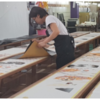- JUL 27, 2021 11:34
Sakura - A Brief Introduction of Japan's National Flower
The moment the first few cherry trees start to blossom you know it is sakura season. However, sakura is more than just a flower, it is an important part of Japanese culture.
- LIKE28
- 8533views

Sakura
Sakura, or cherry blossom, mark the beginning of spring every year with its beautiful white and pink petals. Although cherry trees can be found throughout various parts in the world, mainly in regions in the Northern Hemisphere, cherry blossoms are undeniably associated with Japan. Depending on the region, the sakura blossom season usually starts from mid-March in the southern islands of Okinawa and spreads all through the Honshu main island until they reach Hokkaido at the end of April. However, sakura is more than just a flower, it is part of Japanese history and culture. From the moment the first few buds start to bloom until the entire Prunus serrulata cherry tree is in full bloom. It merely last for two weeks, yet is a spectacle one must to experience. Due to the brief period sakura they represent the beauty of temporary and ephemera life, and remind us that all things will eventually pass. It comes to no surprise that there are countless songs, poems, or painting that are dedicated to sakura.
Cherry Blossom Forecast
Based on the bloom timeline of the official observation trees that are located at the 58 Japan Meteorological Agency offices across the country, each year the Weathermap releases a cherry blossom forecast map. It explains in detail when and where the cherry tree will start to blossom. The forecast separates between “First bloom”, which indicates that approximately 5 to 6 flowers of the observation trees have bloomed, together with “Full bloom” that indicates that at least 80% have bloomed. In Tokyo the cherry trees at Yasukuni shrine serve as official observation trees.

Hanami
As the days are getting warmer, Japanese people flock to nearby parks, temples, or castles, to appreciate the cherry blossom with family and friends. People bring delicious food and drink in order to enjoy sakura to the fullest. This is called hanami (which means looking at flowers). Since sakura can be found all over Japan the Japan Cherry Blossom Association published a list of the best spots in each prefecture to do hanami. During this season it is common to find shops and restaurants that sell sakura themed culinary and products, such as rice cake, bento, coffee and many more. Not only are they visually super appealing, their sweet taste feels like spring.
History
The first official cherry blossom viewing party was held by Emperor Saga in 812. However, the first records describing the beauty of sakura are from the Nara Period (710-794) in Manyoshu, Japan’s oldest existing collection of poetry. In Shinto religion, sakura was originally used as an offering to gods during the rice planting season.
Only at the end of the Heian Period (794-1185) had cherry blossom viewing parties become a social event for the elite of the country. Those festive gatherings would always include drinking sake and eating plenty of food beneath the beautiful cherry trees. It was also the time when artist began to capture the beauty of sakura in their artwork through music and poetry.
Hanami was initially an exclusive event for the upper class until the Edo Period (1603-1867). That was when the shogunate and military gained significant influence and power over the country, and as a result rendered the control of the ruling emperor to a minimum. Once the samurai started to engage in cherry blossom viewing parties it was only a matter of time when the general public followed suit.

Sakura in present day Japan
In Japan sakura and spring season reflect the beginning of a new area. In most countries around the globe students graduate in summer. Japan on the other hand, celebrates their graduation during this seasons. It is also the time when young people start to enter the labor force and kick start their career, after the long and intense shukatsu (job hunting).
Unfortunately, there is valid concern that the current cherry trees may die off. A large number of current cherry trees are already quite old, as they were planted after the Second World War. The roots of cherry trees are not deep, which means that they can be easily damaged. Furthermore, unlike other trees they do not grow from seeds but rather from cutting. Changes in the environment could dramatically affect sakura the way we know them today. In order to keep one of Japan’s most iconic symbol for future generations, thorough planting measures are much needed.
(By Stefan)


Japanese Folk Song: Cherry Blossoms (さくら さくら, Sakura Sakura)
A List of the Best Spots in Each Prefecture to Do Hanami
Japan travel guide
posted by
- Powered by KIMONO BIJIN
Tags
You May Also Like
-
Tokamachi has a unique history as a kimono and textile production town, being nationwide accla...
- Sabikimono
- 2597views
-
How I started my Kimono journey in Tokyo and created my first handsewn Kimono within 6 months.
- Sabikimono
- 2641views
-
Makeup Artist Paladini PePe About Special Effect Makeup, the Future of Beauty, and Sadako
Whether it be photo shootings or film sets, they are a true master of their craft, and behind ...
- WAi! WAi! JAPAN
- 5205views
-
JLPT Needs to Change, and Here Is Why
The Japanese Language Proficiency Test is the most widely used Japanese language ability tests...
- WAi! WAi! JAPAN
- 5615views
-
5 Underrated Shrines and Temples in Tokyo and Japan
Five of the most underrated holy places in Tokyo. A must visit for people who cannot get enoug...
- WAi! WAi! JAPAN
- 6035views















